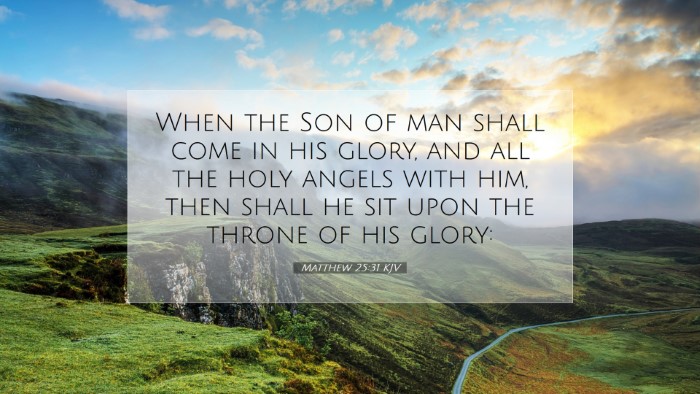Commentary on Matthew 25:31
Matthew 25:31 states: "When the Son of Man comes in his glory, and all the angels with him, he will sit on his glorious throne." This verse serves as a profound introduction to the parable of the sheep and the goats, emphasizing the future judgment of humanity and the glorious return of Christ.
Contextual Overview
This passage occurs within Jesus' Olivet Discourse, wherein He addresses His disciples regarding the end of the age and His second coming. As Albert Barnes notes, the verses preceding this one detail the necessity of vigilance and preparedness among believers.
Interpretation of 'The Son of Man'
The title "Son of Man" attributed to Jesus underscores both His humanity and divine mission. Adam Clarke emphasizes that this term indicates a fulfillment of the messianic prophecy, linking the deity of Christ with His role as the redeemer of mankind. The appellation implies both an exalted position and a profound connection with human experience.
The Coming in Glory
The statement regarding His coming "in glory" indicates not just a return but a manifestation of divine majesty. Matthew Henry comments on this aspect by highlighting that this return will be characterized by visible signs of His glory, distinguishing it from His initial humble entrance into the world.
The Role of Angels
The mention of angels accompanying Jesus enhances the grandeur of His return. Barnes notes that this illustrates His authority over the heavenly hosts, signifying divine approval and power. It speaks to the grandeur and spectacle of the event—depicting not only the significance of Christ's return but also the involvement of the celestial beings in His kingdom work.
Judgment Seat
Jesus’ position upon the "glorious throne" denotes His role as the ultimate judge. Matthew Henry elaborates on the accountability all humanity will face, suggesting that this throne symbolizes authority over all creation. This underscores a necessary theme of righteousness and justice inherent in the final judgment, reflecting God’s holiness.
Theological Implications
The implications of this verse are enormous. It presents a clear teaching on eschatology—Jesus’ second coming and final judgment are not mere future events, but profound truths that should shape the present life of believers. Adam Clarke asserts that understanding this reality is crucial for living a life that is pleasing to God.
Reflection for Believers
For pastors and theologians, this passage offers a rich ground for imparting eschatological teachings that encourage the faithful to remain vigilant. The assurance of Christ's return should foster hope and motivate righteous living.
- Be prepared for Christ’s return by living in obedience to His teachings.
- Understand the gravity of judgment and its implications for personal and collective faith.
- Recognize the importance of sharing the Gospel in light of the coming judgment.
Conclusion
Matthew 25:31 serves as a critical reminder of both the majesty of Christ's return and the reality of judgment. By incorporating insights from multiple public domain commentaries, we gain a deeper understanding of this pivotal verse, urging believers to stand firm in faith as they await the glorious coming of their Lord. It is a call to introspection, encouraging one to align their life in accordance with the teachings of Christ and to be active participants in His kingdom work.


